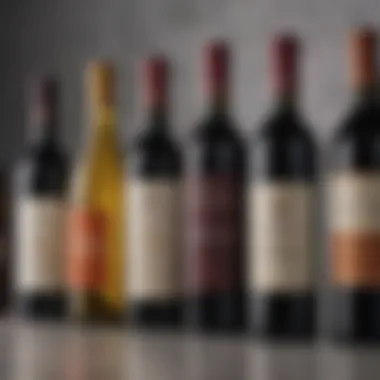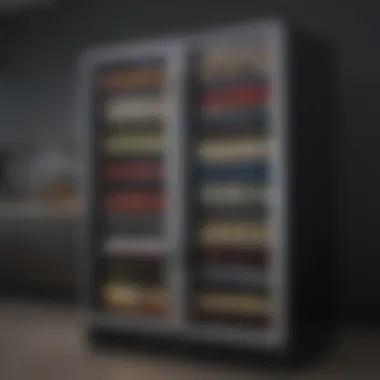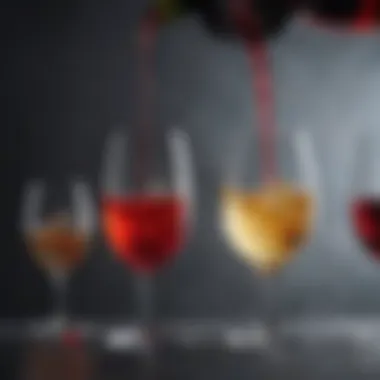Optimal Temperature Settings for Wine Refrigeration


Intro
Temperature impacts every aspect of wine, from taste to aging potential. Different varietals require different conditions. For instance, reds and whites have different temperature ranges that enhance their unique profiles. Some people may underestimate the importance of a consistent environment for wine storage, leading to potential spoilage or diminished quality.
In this article, we will examine specific temperature recommendations for various types of wine. We will also explore the technology behind wine refrigerators and how it contributes to optimal storage conditions. With this guide, wine enthusiasts and casual drinkers alike will gain valuable insight into preserving their collection.
This exploration will not only highlight ideal storage conditions but also reinforce the significance of temperature in wine quality. Thus, understanding this aspect can elevate the whole experience of wine enjoyment.
Understanding Wine Storage
Wine storage is a critical aspect of preserving the quality and character of wine. Understanding the fundamentals of how wine is meant to be stored can greatly impact its taste, aroma, and overall enjoyment. This section outlines essential elements such as temperature, humidity, and environmental conditions that contribute to effective wine storage.
One of the primary considerations in wine storage is temperature. Storing wine at the right temperature prevents spoilage and promotes optimal aging. For wine enthusiasts, knowing how temperature affects wine can help them maintain their collections properly.
Fundamentals of Wine Aging
Aging is a significant process for most wines, particularly red wines. It allows for complex flavors to develop. When wines are stored at the correct temperatures, chemical reactions occur over time, enhancing the wine's depth. However, when temperatures vary too much or reach extremes, the wine can age improperly.
Factors such as storage temperature influence this process. Wines that age well typically require a stable temperature, ideally between 50°F and 57°F (10°C and 14°C). Fluctuations can cause the wine to expand and contract, possibly allowing air to enter the bottle, leading to oxidation.
Wine Composition and Its Variabilities
Different types of wine have varied compositions that require distinct storage conditions. The balance of sugars, acids, and tannins significantly varies, which affects how they should be stored. For instance, a full-bodied red wine may benefit from a slightly warmer storage temperature compared to a delicate white wine.
Understanding these variances enables wine collectors to make informed decisions. Factors such as the grape variety, production method, and intended aging can influence these requirements. Additionally, variation in wine corks, whether natural or synthetic, can also determine how a wine breathes during storage. Thus, knowing the composition of specific wine types can guide proper storage practices.
"Proper storage is not only about the environment; it’s about understanding the wine itself."
The Role of Temperature in Wine Preservation
Temperature is a critical factor in the preservation of wine. It affects not only the flavor but also the longevity of the wine. Inadequate temperature management can lead to significant issues, such as unwanted chemical reactions, spoilage, and loss of character. When wine is stored at the right temperature, it remains stable and can mature gracefully over time, enhancing its qualities rather than diminishing them.
Different types of wine require specific temperatures to reach their full potential. Understanding these nuances is vital for anyone interested in wine. The term "optimal temperature" is not just about comfort; it refers to a range in which wine can evolve positively without adverse effects. Therefore, every wine enthusiast should prioritize temperature control to protect their investments and enjoy the best possible wine experience.
Optimal Temperature Ranges
Red Wine
Red wine requires a warmer storage temperature compared to other types. The ideal range is typically between 55°F and 65°F (13°C to 18°C). This temperature promotes the development of complex flavors while preventing premature aging. The key characteristic of red wine is its tannin structure, which can soften and integrate with other components over time. A beneficial attribute of red wine is its ability to improve with age, but this potential diminishes if exposed to temperatures that fluctuate or consistently exceed recommended levels.


White Wine
White wine, while also deserving of careful temperature control, is generally best stored at cooler temperatures, 45°F to 55°F (7°C to 13°C). This range preserves the crisp acidity that is characteristic of white wines. One major advantage is that cooler storage limits the development of off-flavors due to oxidation. However, storing white wine too cold can mute flavors. Finding a balance is crucial to maximizing enjoyment.
Sparkling Wine
Sparkling wine requires similar temperatures to white wine, usually between 40°F and 50°F (4°C to 10°C). A defining feature of sparkling wine is its carbonation, which can be affected negatively by temperature extremes. Keeping sparkling wines too warm may cause them to lose effervescence, while too cold can prevent the wine's aromatic elements from emerging. This sensitivity emphasizes the need for careful temperature management in relation to the wine's unique characteristics.
Fortified Wine
Fortified wine, like Port and Sherry, offers a slightly different case. These wines perform admirably in a range of 50°F to 60°F (10°C to 15°C). The higher alcohol content provides a degree of resilience against temperature fluctuations. Nevertheless, extreme temperature shifts can still compromise quality. The complexity of flavors in fortified wines makes them a popular choice for collectors, but understanding their storage needs is essential for preserving their integrity.
Consequences of Incorrect Temperature
Flavor Degradation
Flavor degradation is perhaps one of the most significant risks associated with incorrect temperature storage. When wine is exposed to unsuitable conditions, desirable flavors can fade or become harsh, leading to an unpleasing tasting experience. The impact of flavors can vary across different types of wine, but generally, higher temperatures accelerate aging while lower temperatures can suppress character. A good storage practice is imperative to mitigate these risks and maintain flavor integrity.
Oxidation Risks
Oxidation represents a serious threat in the realm of wine preservation. Prolonged exposure to air, especially at elevated temperatures, increases the risk of oxidation. This process alters aromas and flavors, typically resulting in a flat or overly nutty character that is not ideal. Ensuring an environment that controls both temperature and air exposure is crucial for minimizing these oxidation risks. By managing these factors, the wine's original profile can be preserved.
Storage Stability
Stability of wine during storage refers to its ability to withstand external factors without undergoing detrimental changes. If wine is subjected to extreme temperature variances, stress is placed on its organics, leading to compromised quality. Investing in proper refrigeration solutions designed for wine storage can help achieve greater stability. Thus, careful thought should be given to temperature management as part of a broader strategy for maintaining optimal wine quality.
Recommended Temperature Settings for Wine Fridges
Selecting the correct temperature setting for wine fridges is essential. This choice has a direct impact on the quality and longevity of the wine. Not only does temperature affect the physical state of the wine, but it also influences its flavor development and overall preservation. Therefore, understanding the ideal temperature for wine storage is significant not just for casual drinkers but also for serious enthusiasts. Making informed decisions about these settings can enhance the drinking experience and prolong the life of the wine.
General Recommendations
When it comes to general recommendations for wine storage, there are a few key rules to follow. The ideal temperature range for wine is generally between 45°F and 65°F. This range supports optimal preservation and aging. Here are specific details that can help:
- Whites and Rosés: Typically stored between 45°F and 50°F. This slightly cooler temperature preserves freshness and enhances acidity.
- Reds: Best kept at 55°F to 65°F. This temperature range allows for more complex flavor development.
- Sparkling Wines: These should ideally be at 40°F to 50°F, which maintains their crispness and effervescence.
- Fortified Wines: It is suggested to store these at 50°F to 60°F. This temperature range helps retain their higher alcohol content while balancing their intrinsic sweetness.
Maintaining consistency is crucial as well. Frequent fluctuations in temperature can harm the wine, leading to undesirable flavors and aromas.
Specific Settings for Different Wine Types
Tailoring specific temperature settings to different wine types can further optimize storage conditions. Here are detailed guidelines:


- Red Wine: Aim for a little warmer settings, around 55°F to 65°F. Use a thermostat to regulate the temperature consistently, avoiding extremes which can cause flavor loss and spoilage.
- White Wine: The cooler side, at about 45°F to 50°F, works best. This setting preserves the fresh notes and lively acidity, which are often hallmark characteristics of white wines.
- Sparkling Wine: For these wines, focus on 40°F to 50°F. Cold temperatures are important, especially before serving. Chilling should happen in advance to enhance the drinking experience.
- Fortified Wine: Store these at around 50°F to 60°F. This temperature helps prevent oxidation while also maintaining flavor integrity.
By understanding these specific settings, wine enthusiasts can achieve optimal preservation and enjoy the full spectrum of flavors each type of wine has to offer.
Technological Considerations for Wine Refrigerators
When it comes to wine preservation, understanding the technology behind wine refrigerators is crucial. Technological considerations involve the mechanical aspects that influence temperature regulation, energy efficiency, and the overall environment inside the unit. Proper technology in wine fridges ensures that wines are stored under ideal conditions, preventing damage and preserving quality over time.
Types of Wine Refrigerators
Wine refrigerators come in two main types: thermoelectric coolers and compressor-based units. Each type has its distinct characteristics, benefits, and limitations that cater to different needs of wine enthusiasts.
Thermoelectric Coolers
Thermoelectric coolers rely on the Peltier effect, a technology that creates a heat differential across two different materials. This method is silent and compact, making it a favorable option for many homeowners. The key characteristic of thermoelectric coolers is their gentle and steady cooling ability, which is crucial for maintaining stable temperatures. This technology is especially popular for smaller wine collections or for those who prioritize convenience.
One unique feature of thermoelectric coolers is their lack of moving parts. This results in a quieter operation compared to compressor-based units which may be beneficial in noise-sensitive environments, like home theaters or libraries. However, they usually have lesser cooling capacity and are better suited for wines in cooler climates. A disadvantage includes their performance being affected by ambient temperatures. Thus, in extremely hot conditions, these coolers may struggle to reach the desired temperature.
Compressor-Based Units
Compressor-based units operate like traditional refrigerators, using a compressor to circulate refrigerant. This method provides more significant cooling power and is suitable for storing larger wine collections. A key characteristic of compressor-based units is their efficiency in maintaining precise temperature levels, making them ideal for varying climates and larger spaces.
The unique feature of compressor-based units is their ability to handle higher ambient temperatures without failure. They can sustain cooler settings even when the room temperature rises. However, they can be louder than thermoelectric coolers due to the compressor cycle, which may be a drawback for some users. Additionally, their larger size might be a consideration for those with limited space.
Energy Efficiency and Its Implications
Energy efficiency plays a significant role when choosing a wine refrigerator. This aspect impacts not only the operational cost but also the environmental footprint of the appliance. Consumers should consider models that offer good insulation, proper sealing, and optimized compressor usage. Better energy ratings often lead to lower electricity bills while also contributing to sustainability efforts.
Furthermore, efficient energy use helps in maintaining a stable temperature in the wine fridge. Fluctuations can negatively affect the aging process of the wine. An understanding of energy efficiency can lead to informed purchasing decisions, ensuring both quality preservation of wine and savings on utility costs.
Environmental Factors Affecting Wine Storage
In the realm of wine preservation, the impact of environmental factors cannot be overstated. Temperature may receive the lion's share of attention, but elements such as humidity, light exposure, and vibration levels also play critical roles. Each factor interacts in unique ways, influencing the overall longevity and quality of wine. To secure the best outcomes for collection, understanding these nuances is essential for both connoisseurs and casual enthusiasts alike.
Humidity Levels
Humidity is one of those often overlooked aspects of wine storage. Keeping wine corks in the best condition is essential. If humidity is too low, corks can dry out, leading to wine oxidation and spoilage. On the other hand, excessive humidity can foster mold growth on bottles, potentially damaging labels and making storage less appealing. The recommended humidity range is between 50% to 70%. Regular checks with a hygrometer can help maintain ideal conditions. Indeed, managing humidity might require a bit of investment in equipment, like specialized humidifiers. This investment pays off in protecting the integrity of the wine.
Light Exposure


Light is another factor that can adversely affect wine storage. Exposure to ultraviolet (UV) rays, especially, can degrade the wine's quality. Clear and green bottles allow more light penetration, making wines inside them vulnerable to damage. In contrast, amber and dark bottles are preferable as they block light effectively. Ideally, wine should be stored in dark environments. For those who use display shelves, consider UV-filtering glass or simply cover bottles when natural light is around. Prolonged exposure to light can lead to off-flavors and deterioration of flavor compounds—a detail that any serious wine collector should heed.
Vibration Control
Vibration control is a factor that is often underestimated in wine storage. Continuous movement can disturb the sediment in the bottle, which may lead to unwanted chemical reactions. The internal structure of wine can be adversely influenced by vibrations that come from nearby appliances, heavy foot traffic, or even changes in temperature. For best results, keep wine fridges or cellars isolated from high-vibration areas. Moreover, choosing a wine refrigerator with good insulation can help minimize unnecessary movements. Importantly, maintaining a stable environment frees the wine from agitation, allowing it to age gracefully over time.
Practical Tips for Wine Fridge Users
Understanding how to effectively utilize a wine fridge is essential for maintaining the quality of your collection. Many enthusiasts invest in specialized appliances without fully grasping their functionality. Implementing practical tips can help maximize the effectiveness of temperature control, which is crucial for preserving the integrity of various wines.
Monitoring Temperature Accuracy
Temperature accuracy is foundational for efficient wine storage. Inconsistent temperatures can lead to adverse effects on the wine, such as excessive aging or flavor loss. To ensure that your wine fridge is operating within the desired range, consider the following strategies:
- Use a reliable thermometer: Invest in a high-quality thermometer to measure the internal temperature of your wine fridge. Many models include digital displays for precision.
- Check periodically: Regularly monitor the temperature readings, especially during seasonal changes. Fluctuations can occur due to increased or decreased ambient temperature.
- Calibrate if necessary: If you find discrepancies, calibration may be required. Refer to the manufacturer’s guidelines to adjust your wine fridge settings for optimal conditions.
By consistently tracking the temperature, you can avoid situations where the wine deteriorates quickly. The optimal range varies between different wines, so understanding these specifics is vital.
Best Practices for Loading Wine
The way you load a wine fridge can affect airflow and temperature distribution. Here are some best practices to consider:
- Arrange by type: Store similar wines together, as they likely require similar temperatures. For instance, red wines typically need a warmer setting compared to whites.
- Leave space for airflow: Avoid overcrowding the fridge. Allow space between bottles for proper airflow, which aids in temperature regulation.
- Position thoughtfully: Place bottles horizontally if they have corks. This keeps the cork moist and prevents it from drying out. For sealed bottles, vertical storage is acceptable.
Implementing these practices can help to maintain an ideal environment for your wine. Think of loading your wine fridge as laying the foundation for long-term preservation.
"Proper loading techniques and temperature monitoring are essential for the longevity and enjoyment of your wines."
By incorporating these practical tips, wine fridge users can significantly enhance their wine storage experience, ensuring that each bottle remains in optimal condition for future enjoyment. The focus on accuracy and careful loading aligns with best practices for wine preservation, contributing to the overall quality of the collection.
Ending
Recap of Key Points
To summarize key points discussed in this article:
- The ideal temperature for wine varied depending on the type, with general ranges recommended for red, white, sparkling, and fortified wines.
- Incorrect temperature settings lead to adverse effects such as flavor degradation, oxidation, and compromised storage stability.
- Wine refrigerators offer specialized technology, including compressor and thermoelectric systems, to meet these storage needs.
- Humidity, light, and vibration are environmental factors that have a substantial impact on wine preservation.
- Practical tips, such as monitoring temperature accuracy and optimal loading practices, are critical for wine fridge users.
Ensuring that these factors align with best practices contributes to maximizing the life and taste of your wine.
Future Considerations for Wine Storage
Looking ahead, several considerations will shape the future of wine storage:
- Advancements in Technology: As technology evolves, new refrigeration systems may offer enhanced features, like smart monitoring that connects to mobile devices.
- Sustainable Practices: There may be an increasing focus on energy-efficient models and sustainability in wine refrigeration, promoting environmentally friendly options for consumers.
- Personalized Storage Solutions: Customizable wine fridges could emerge, allowing enthusiasts to set precise temperature zones tailored to specific wine collections.
- Education on Wine Care: Continued education for consumers on optimal wine storage practices will remain essential, particularly as interest in unique wines and vintages grows.
These aspects will keep evolving, necessitating an ongoing dialogue within the wine community about how best to store and preserve wine.







